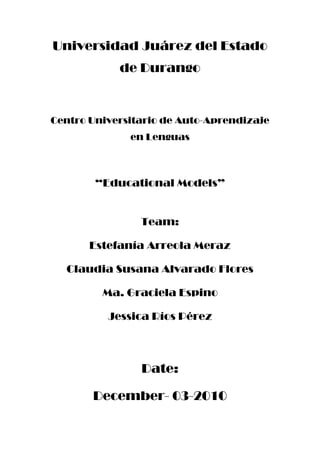
Educational Models
- 1. Universidad Juárez del Estado de Durango <br />Centro Universitario de Auto-Aprendizaje en Lenguas<br />“Educational Models”<br />Team:<br />Estefanía Arreola Meraz <br />Claudia Susana Alvarado Flores<br />Ma. Graciela Espino<br />Jessica Ríos Pérez <br />Date:<br />December- 03-2010<br />Educational models<br />Behavioral Learning Theory<br />Theory proposed by Skinner.<br />This learning occurs when a change of behavior in students, from the behavioral standpoint, the teacher leads a stimulus in the student waiting for a response that is evident and observable, in this way the professor realizes that he or she has created awareness in the student.<br />Behaviorism is responsible for leading the students toward the learning by means of incentives. It is important in theory to teach students from the simple to the most complex structures. In here the teacher's role is to see that the students have made some progress, and that any of the students was left behind, for this model is not that important a class planning.<br />Some of the main characteristics of this model are the following:<br />Give information to the student with activities so that the students can acquire the knowledge. <br />The teacher is a programmer.<br />One of the strategies of this theory is the programmed learning.<br />Cognitive Learning Theory<br />This theory was proposed by Bruner and Ausubel. In this type of learning the teacher gives the student information, this information can be transmitted by some questions, so that the students can generate their own knowledge.<br />At first, the student is compared with a computer, for example, the student receives inputs from the teacher, then the learner process the information to generate results. However, this theory also points out that the student would give his own interpretation and feelings and the computer does not. In this theory the role of the teacher is only a mediator and is not reporting, and the student plays a more active role. <br />Leer fonéticamente<br />Diccionario - Ver diccionario detallado<br />Escuchar<br />Leer fonéticamente<br />Diccionario - Ver diccionario detallado<br />Cognitive Theories<br />Associative learning <br />Computational theory of learning (ACT) by Anderson<br /> Analogy is based on mind-computer <br />This theory is based on three steps:<br />First you know the information and the organization, then compiled and eventually adapt and generate new knowledge. For this step, it is important to have good materials and it must to be the appropriate.<br />Schema theory <br />Like last theory, it is based on mind-computer analogy.<br />This learning occurs through schemes such as the name implies. They do not give the definition; concepts are just joined together and properly arranged so that it is understandable.<br />There are 3 types of learning:<br />The first is growth that occurs when the student adds new knowledge to expand the information he or she already has.<br />Second, the initial schema is modified.<br /> Third and last, it is restructuring. New schemes are developed from the original and that makes changes in the learner.<br />This theory is strongly recommended to be used only in higher education.<br />Restructuring Learning <br />Learning theory of Piaget's equilibration<br />This learning is accomplished by creating new knowledge, after the conflict occurs there must be an accommodation of the existing data with the new input. In this model it is not only to repeat and copy the information in here the learner has to give meaning to the data itself.<br />Discovery Learning<br />In this theory, students must discover their own knowledge in an active teaching-learning.• Teacher is facilitator<br />• The learner needs a proper and timely use of the material• Prior knowledge <br />Vygotsky’s theory <br />This type of learning is by restructuring<br />The student must receive new input from the teacher then the learner has to accommodate to transform the new information and to give a meaning.<br />This learning is when there is a new data without knowing what it really is, but to get to know more we will understand to finally acquire real meaning.<br />This is generated through teamwork (interaction between students)<br />Reception Learning by Ausubel<br />It generates new knowledge with the process of receiving information. <br />Characteristics of this type of learning:<br />At the moment the teacher presents the class it is important to give many examples related to the topic by explaining them clearly.<br />The student’s role mainly relies on solving problems and recognize examples<br />Use of materials<br />The knowledge can be applied in the future<br /> Knowledge can be transfered<br />The teacher is the mediator<br /> Students are active<br />Socio-Cultural Paradigm<br />Theory proposed by Vigotsky <br />Here the role of the student is active, using this way the learners create their own knowledge.<br /> There are two types of learning, the broad sense (development) and the narrow sense (learning data and information). These two types of learning have to be in balance so that a new knowledge can be generated. In the learning process of this paradigm investigations have to be made so that students generate new information based on their prior knowledge. <br />This type of learning takes place only within the classroom<br />Psychogenetic paradigm<br />Theory proposed by Piaget<br />Characteristics of this paradigm:<br />Based on adult-child interaction<br />Learning occurs through schools<br />This type of learning is based on quot; cultural forumsquot; <br />There must be much interaction between students and teacher, this will help to generate new knowledge<br />The student is seen as a social being<br /> The teacher must be a cultural agent and mediator<br /> The teacher should promote the participation and involvement of their students <br />Escuchar<br />Leer fonéticamente<br /> <br />Diccionario - Ver diccionario detallado<br />Escuchar<br />Leer fonéticamente<br />Diccionario –Bibliography:<br />Dra. Magallanes Perez Eliza, Paradigmas y Enfoque Educativos Tercer Ciclo <br />Ver diccionario detallado<br />